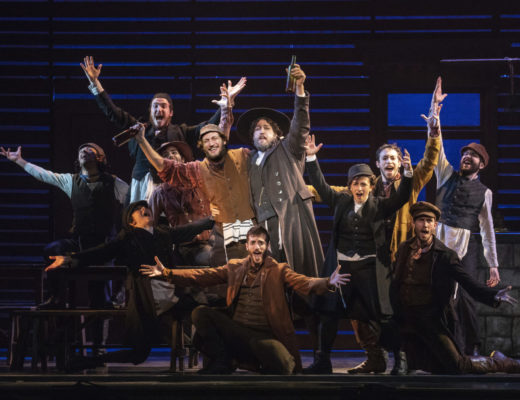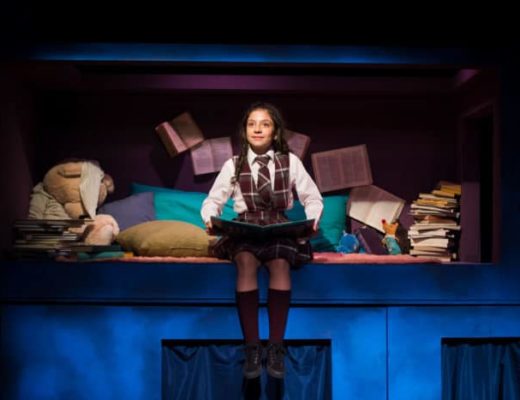Review by Daarel Burnette II
This article was first published in DCTRENDING here.
Blue, an opera by librettist and director Tazewell Thompson, and conducted by Joseph Young and Jonathan Taylor Rush, is a coming-of-age tragedy that’s as much about forgiveness, identity, and the false hopes and expectations of Black men, as it is about police brutality. While the plot is as simplistic as the set, the outsized performances by Kenneth Kellogg and Joshua Conyers make the show worthwhile.
The two-hour-and-fifteen-minute-long production at the Kennedy Center, featuring music by award-winning Jeanine Tesori, and a majority Black cast, a rarity in opera, was canceled in 2020 due to the pandemic.
In the few years since, Americans have witnessed the videotaped murder of George Floyd at the hands of a Minneapolis police officer; a #BlackLivesMatter rally that amounted to the nation’s largest protests in America’s history; a movement to “defund the police;” a marked uptick in crime in majority Black communities; and a concerted political effort to ramp up policing.
Knowing all this, Blue’s plot came across as wanting.
A father, played by Kenneth Kellogg, takes on a job as a police officer for the stable pay, benefits, and an opportunity to fight crime. But his son, played by Aaron Crouch, is soon radicalized by what he sees as abusive treatment of Black men by the police and, to the chagrin of his father, starts participating in street protests where he’s shot and killed. The father, in his grief, goes into a rage and vows revenge against the officer who killed his son.
A bit surreal.
Yet this stellar cast sings with such conviction that a rousing aria, performed by Ariana Wehr, in which she evokes real-life police shootings, generated in me the same flash of anger and grief I feel every time I watch yet another video of police officers senselessly abusing Black men.
And I can’t help but admire Thompson’s decision to cast the father as a police officer (an earlier draft cast the father as a jazz musician). That’s a plot twist that we’re now grappling with in the real-life beating of Tyre Nichols, a Black father, at the hands of four Black Memphis police officers.
Are Black police officers first Black or blue?
In the opening scene of Blue, we see the work of costume designer Jessica Jahn, spot lit by lighting director, Robert Wierzel, switches from the uniform of a Black man – a Negro league baseball crew coat, baggy blue jeans, and a fitted sports cap– into the uniform of a cop–creased, blue slacks, crisp, blue collared oxford, blue peaked hat, silver officer badge and a black handgun.
This opening scene is the most dynamic that the set, designed by Cindy Oxberry, ever gets. Throughout the production, cast members roll visibly cheap and mismatched, black and white furniture on and off the stage, which is backlit by Harlem row houses whose lights confusingly flicker off and on.
In the next scene, we’re serenaded with an aria sung by a whimsy cast of girlfriends played by Ariana Wehr (soprano), Katerina Burton (soprano) and Rehanna Thelwell (mezzo-soprano), as they first praise the mother, played by Brianna Hunter (mezzo-soprano), for snagging a “big-everything” Black man but are then horrified to learn she’s expecting a Black baby boy. How, they ask, will she protect a Black boy from a racist society? How will she (?) a Black boy from the police?
The plot delves into a century-old trope perpetuated by the casting of Black men on stage: victims with no agency, or rage-filled perpetrators. This is damaging and something I hope the opera world will soon move beyond.
Blue is at its best during arias where the cast, led by the baritone reverend (Joshua Conyers), grieves over the son’s loss. But there are several subplots that leave the audience with more questions than answers. This renders the complications around police brutality for opera’s majority-white audience distant, abstract, and easy-to-fix.
Further, the impact of rampant crime in Black neighborhoods on victims and perpetrators–what accused police departments are solely charged with addressing– is a distracting hole in Blue.
Today, civil rights activists are in the throes of a century-long battle trying to make Black communities safer and policing more effective. It’s a drama worth accurately telling.
As the opera community grapples with its stained history of Blackface, refusing to cast Black performers, and subjugating Black stories, Blue is a welcome attempt to reverse course.





No Comments